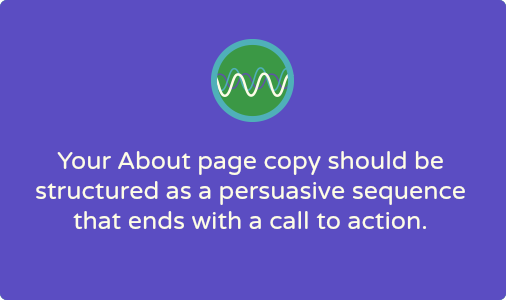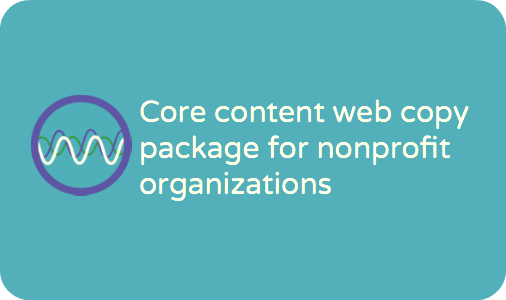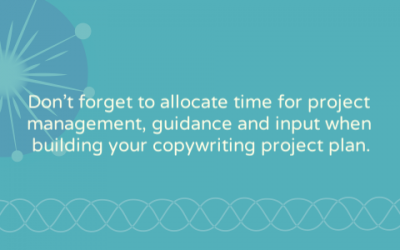Do you know how to write a nonprofit About page?
I like to work with copywriting formulas, but it’s hard to find one for this purpose. So, inspired by a combination of existing formulas for writing website copy, and introducing a few ideas of my own, I have created a nonprofit About (or About Us) page formula for my clients – and for you!
About pages often attract high-quality traffic; people who are interested in your organization. So use your About page to draw visitors into your organization’s story, describe the problem you are solving and show how you are equipped to solve that problem. If written well, your About page will communicate why your organization matters and why it is the solution for people who care about your cause.
Your nonprofit’s About page copy should be concise and conversational, free from jargon, insider terminology and acronyms, and like any strong copy, should be written for your readers first.
Structure your #nonprofit's About page copy as a persuasive sequence, ending w/a call to action Click To TweetThe About page copywriting formula that I explain below helps with everything I’ve described above. When you use it, you’ll structure your copy elements in a persuasive sequence that ends with a call to action. You’ll include relevant details without dumping in everything but the kitchen sink. It’s an outline; all you have to do is source and assemble (and of course, finesse) the pieces.
Note: I’ve included example copy elements below, but they aren’t necessarily from About pages that follow this exact sequence. More on that at the very end of the post.
Here’s how to write a nonprofit About page in seven steps
Step 1: Identify the problem you are solving
Have a look at a few nonprofit About page introductions and you’ll see:
“X organization was established in…”
“Y is a registered charity that…”
“For over [number] years, Z organization…”
“With [number] of locations in communities across the [country/province/state/region]…”
And many nonprofit About Us pages just jump straight to the organization’s mission, vision and values.
I’m not suggesting that there’s anything wrong with talking about the longevity of your organization, it’s size and scope or your charitable status. But I’d propose that you avoid leading with this information.
Instead, tell your reader why your nonprofit matters, right away: describe the problem you are solving. What is the cause or issue your organization is working to address?
In this excerpt, you’ll see that Maytree does an excellent job of this type of introduction. They also manage to position the organization within the opening statement:
“At Maytree, we believe that poverty is created when economic and social systems do not keep pace with our changing world. This impacts the quality of life in our communities.
The most enduring way to fix the systems that create poverty is to safeguard economic and social rights for all people living in Canada”.
Internal link opportunity
If your nonprofit has a page or section explaining your cause or issues, link to it from your introduction.
Step 2: Bring in your nonprofit’s history/story
Now, introduce information about your organization’s origins; this is where you bring a little storytelling into your About page. If you can, talk about your founders, what inspired them to form your organization and a few of their early steps and successes.
Here’s an excerpt from the Cleveland Community Foundation:
“[Frederick H.] Goff was already an elite professional and the former mayor of what had been the city of Glenville when he hatched the idea of a “community trust.”
His vision was to pool the charitable resources of Cleveland’s philanthropists, living and dead, into a single, great, and permanent endowment for the betterment of the city. Community leaders would then forever distribute the interest that the trust’s resources would accrue to fund “such charitable purposes as will best make for the mental, moral, and physical improvement of the inhabitants of Cleveland.”
From that revolutionary idea, the Cleveland Foundation was born on Jan. 2, 1914. Within weeks, the foundation began reshaping the way community members care for one another not just in Greater Cleveland, but around the nation and the world…”
Internal link opportunity
Some readers will be interested in your nonprofit’s full history. If you have a separate timeline or history page on your site, link to it.
Step 3: Describe your organization’s impact
You’ve explained the problem your nonprofit is working to address. Now it’s time to talk about impact. Provide data or stories that show the difference your organization has already made, your effectiveness and why you deserve support.
As you can see in this About Us page excerpt, Pathways to Education communicates impact effectively:
“The results of this unique program have been ground-breaking, improving graduation rates by an average of 85 per cent across Pathways communities. Over 73 per cent of all students who graduated from high school while in the Pathways Program have gone on to post-secondary education or training.”
Step 4: Describe the specific work you do
On many nonprofit About pages, you’ll find a list of programs or services. You do need to explain how you work to fulfill your mission, but it needs to be in context. The good news: if you’ve been following this sequence so far, you’ve created that context.
You’ve introduced a problem and the story about how your organization emerged and organized to solve it. You’ve talked about the difference you’ve already made. Now you can shed a little light on how you make those gains. Describe the programs and projects your organization delivers to work toward mission fulfillment.
This excerpt shows the ACLU getting specific within a “How we do it” section of their About page:
“…We appear before the Supreme Court more than any other organization except the Department of Justice.
In addition, we work to change policy as well as hearts and minds. Our Washington Legislative Office lobbies Congress to pass bills that advance or defend civil liberties and defeat those that do not, our affiliates work in state houses across the country to do the same, and we use strategic communications to engage supporters on the most pressing civil liberties issues of our time…”
Internal link opportunity
You’re just going to touch on a couple of examples on this page, so make sure to link to your programs or services page from here.
Step 5: Include a testimonial
It’s time to back up your story and, in copywriting terms, your “claims.” So introduce what I call a belief builder; a copy element that proves your organization’s credibility. I believe that a testimonial or quote works nicely on an About page, but I’ve written an entire post about belief builders and where to find them, so have a look if you’d like some other ideas.
Here’s a testimonial featured on TechSoup Canada’s About page:
“Thanks to TechSoup Canada, we have been able to provide for the needs of more children and their families in Mumbai India. In addition to saving money, we were able to introduce the children and staff in India to more benefits of computer use in their lives and in the classroom.”
Step 6: Explain your nonprofit’s future aspirations
As you near the end of your About page, help readers to get a sense of your plans for the future by sharing your future aspirations. You can draw long-term goals from your mission statement, or pull details from your current strategic plan about what you’re tackling in the next one to five years – or both!
In Heart and Stroke’s “What we do” content, they explicitly state their future goals:
“The threat of heart disease and stroke is more urgent than ever, with our aging population and rising rates of obesity and diabetes. That’s why we’ve set ambitious targets.
*10% reduction in risk factors for heart disease and stroke by 2020
*25% reduction in the death rate from heart disease and stroke by 2020″
Internal link opportunity
You moved your mission, vision and values statement to a separate page when you decided to write this stellar About page copy, right? Link over to that page now.
Step 7: Invite your readers to take action
I recommend that you place a call to action in your web copy whenever possible, including your About page. Encourage your readers to do something now that they’re getting to know you better.
The call to action you choose depends on your web content strategy and the actions you’ve prioritized (program registration, donation, signing a petition, etc.) But here’s an option that probably makes sense: ask these readers, who are clearly interested in learning more about you and what you do, to sign up for ongoing email updates.
The anti-poverty organization Heartland Alliance ends their About page with email sign up form that includes this message:
“Poverty, Homelessness, Injustice End Here
If you believe that every life can change, we’ve got more to share.”
Will you be testing out this new copywriting formula?
What do you think? Would your new About page – with all of these elements pulled together in this sequence – be a big improvement?
A final note: you’re probably wondering why I haven’t provided an example of this full sequence in action. I developed this formula last year for new client websites that still have not gone live (I’m sure you can relate to web launch delays). When the new sites are up, I’ll link over. Meanwhile, if you spruce up your organization’s About page using my seven-step sequence, share it in the comments below!
Need to write a nonprofit About page? Here's a 7-step copywriting formula (plus worksheet) #NPMC Click To Tweet


![Internal copy review pet peeves – and help with getting useful feedback [includes swipe copy]](https://moflow.ca/wp-content/uploads/2021/02/sharable-boxes-3-400x250.png)

